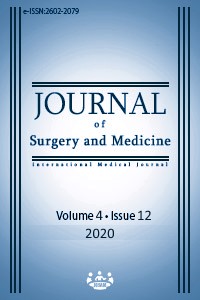An epidemiological and clinical analysis of cutaneous drug eruption: A cohort of 164 patients
Keywords:
Cutaneous Drug Eruptions, Reaction patterns, Epidemiological and clinical features, ScalesAbstract
Aim: Drug reactions are important and frequent complications of medical treatments. In this study we aimed to investigate the patients hospitalized with a diagnosis of cutaneous drug eruptions, implicated drugs, and related skin manifestations considering the literature. Methods: This retrospective cohort study was performed in Haydarpaşa Numune Training and Research Hospital, Dermatology and Venereology Department. The study comprised 164 patients that were diagnosed with cutaneous drug eruption between January 2010 and December 2016. Some parameters, such as demographic characteristics, type of the reaction, culprit drug groups, multiple drug usage, time between the onset of the drug intake and beginning of the eruption were recorded. Age, gender, symptoms, laboratory tests, diagnosis and treatment information were obtained through patient files. Causal relationship was assessed by Naranjo algorithm. Adverse drug reactions were categorized as definite, probable, possible, and absent. All values were expressed in percentages. The severity of the reaction caused by the drug was assessed with Hartwig's Severity Assessment Scale. Results: Among 164 patients, there were 104 females and 60 males with a mean age of 46.3 (18.8) years. The most commonly encountered type of drug reactions were urticaria and angioedema (42.1 %), followed by morbilliform drug eruption (31.7%). More cutaneous reactions were noted with NSAIDs (18.9%), antibiotics (15.2%) and the combination of NSAIDs and antimicrobial agents (9.8%). Time between the onset of eruption and the intake of the drug varied by hours to months. Some of these patients also described similar reactions related to drugs in the past. Conclusion: Knowledge of these drug eruptions, the causative drugs and the prognostic factors is important for clinicians. It is recommended to advise patients to carry a list in their wallets indicating their drug allergies and/or intolerances, especially if they had a severe reaction before. We conclude that a careful follow-up should be performed with NSAIDs, antibiotics and anti-epileptics. The combination of drugs, including NSAIDs and antibiotics should be avoided as much as possible.
Downloads
References
Temple ME, Robinson RF, Miller JC, Hayes JR, Nahata MC. Frequency and preventability of adverse drug reactions in paediatric patients. Drug Saf. 2004;27(11):819-29. doi: 10.2165/00002018-200427110-00005. PMID: 15350153.
Kessler DA. Introducing MEDWatch. A new approach to reporting medication and device adverse effects and product problems. J Am Podiatr Med Assoc. 1994 Jan;84(1):35-8. doi: 10.7547/87507315-84-1-35. PMID: 8295131
Zaraa I, Jones M, Trojjet S, Cheikh Rouhou R, El Euch D, Mokni M, Ben Osman A. Severe adverse cutaneous drug eruptions: epidemiological and clinical features. Int J Dermatol. 2011 Jul;50(7):877-80. doi: 10.1111/j.1365-4632.2010.04785.x. PMID: 21699528.
Knowles SR, Shear NH. Recognition and management of severe cutaneous drug reactions. Dermatol Clin. 2007 Apr;25(2):245-53. viii. doi: 10.1016/j.det.2007.01.011. PMID: 17430761.
Adışen E, Karaca F, Gürer MA. Dermatolojide İlaç Reaksiyonları. Turk J Dermatol 2008;2:1-5.
Busto U, Naranjo CA, Sellers EM. Comparison of two recently published algorithms for assessing the probability of adverse drug reactions. Br J Clin Pharmacol. 1982;13(2):223-7. doi:10.1111/j.1365-2125.1982.tb01361.
Hartwig SC, Siegel J, Schneider PJ. Preventability and severity assessment in reporting adverse drug reactions. Am J Hosp Pharm. 1992 Sep;49(9):2229-32. PMID: 1524068.
Mokhtari F, Nikyar Z, Naeini BA, Esfahani AA, Rahmani S. Adverse cutaneous drug reactions: Eight year assessment in hospitalized patients. J Res Med Sci. 2014 Aug;19(8):720-5. PMID: 25422656; PMCID: PMC4235091.
East-Innis AD, Thompson DS. Cutaneous drug reactions in patients admitted to the dermatology unit at the University Hospital of the West Indies, Kingston, Jamaica. West Indian Med J. 2009 Jun;58(3):227-30. PMID: 20043529.
Naldi L, Conforti A, Venegoni M, Troncon MG, Caputi A, Ghiotto E, Cocci A, Moretti U, Velo G, Leone R. Cutaneous reactions to drugs. An analysis of spontaneous reports in four Italian regions. Br J Clin Pharmacol. 1999 Dec;48(6):839-46. doi: 10.1046/j.1365-2125.1999.00096.x. PMID: 10594488; PMCID: PMC2014315.
Jelvehgari M, Azimi H, Montazam H. Prevalence of cutaneous drug eruption in hospitalized patients: a report from sina hospital of Tabriz. Iranian Journal of Dermatology. 2009;12(1):16-9.
Valeyrie-Allanore L, Sassolas B, Roujeau JC. Drug-induced skin, nail and hair disorders. Drug Saf. 2007;30(11):1011-30. doi: 10.2165/00002018-200730110-00003. PMID: 17973540.
Ahmed AM, Pritchard S, Reichenberg J. A review of cutaneous drug eruptions. Clin Geriatr Med. 2013 May;29(2):527-45. doi: 10.1016/j.cger.2013.01.008. PMID: 23571043.
Farshchian M, Ansar A, Zamanian A, Rahmatpour-Rokni G, Kimyai-Asadi A, Farshchian M. Drug-induced skin reactions: a 2-year study. Clin Cosmet Investig Dermatol. 2015 Feb 9;8:53-6. doi: 10.2147/CCID.S75849. PMID: 25709487; PMCID: PMC4330003.
Bigby M. Rates of cutaneous reactions to drugs. Arch Dermatol. 2001 Jun;137(6):765-70. PMID: 11405768.
Carneiro SC, Azevedo-e-Silva MC, Ramos-e-Silva M. Drug eruptions in the elderly. Clin Dermatol. 2011 Jan-Feb;29(1):43-8. doi: 10.1016/j.clindermatol.2010.07.006. PMID: 21146731.
Akpinar F, Dervis E. Drug Eruptions: An 8-year Study Including 106 Inpatients at a Dermatology Clinic in Turkey. Indian J Dermatol. 2012 May;57(3):194-8. doi: 10.4103/0019-5154.96191. PMID: 22707770; PMCID: PMC3371522.
Botelho LF, Porro AM, Enokihara MM, Tomimori J. Adverse cutaneous drug reactions in a single quaternary referral hospital. Int J Dermatol. 2016 Apr;55(4):e198-203. doi: 10.1111/ijd.13126. Epub 2015 Dec 29. PMID: 26710962.
Marzano AV, Borghi A, Cugno M. Adverse drug reactions and organ damage: The skin. Eur J Intern Med. 2016 Mar;28:17-24. doi: 10.1016/j.ejim.2015.11.017. Epub 2015 Dec 7. PMID: 26674736.
Yawalkar N. Drug-induced exanthems. Toxicology. 2005 Apr 15;209(2):131-4. doi: 10.1016/j.tox.2004.12.023. PMID: 15767025
Sasidharanpillai S, Riyaz N, Khader A, Rajan U, Binitha MP, Sureshan DN. Severe cutaneous adverse drug reactions: a clinicoepidemiological study. Indian J Dermatol. 2015 Jan-Feb;60(1):102. doi: 10.4103/0019-5154.147834. PMID: 25657416; PMCID: PMC4318022.
Downloads
- 702 646
Published
Issue
Section
How to Cite
License
Copyright (c) 2020 Dua Cebeci, Şirin Yaşar, Sema Aytekin, Fatih Göktay, Pembegul Güneş
This work is licensed under a Creative Commons Attribution-NonCommercial-NoDerivatives 4.0 International License.
















